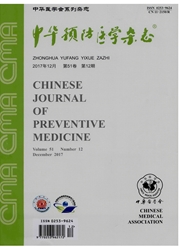

 中文摘要:
中文摘要:
目的掌握地理景观因素对长沙市。肾综合征出血热(HFRS)传播的影响。方法收集2005-2009年长沙市各乡镇HFRS发病数据,共327例;收集整理2005-2009年长沙市人口数据、第二次全国土地调查数据及长沙市气象数据,建立长沙市乡镇尺度HFRS疫情景观因素空间数据库。采用时空聚类分析与泊松回归分析方法,探索长沙市2005-2009年HFRS传播的时空分布与地理景观影响因素。结果2005-2009年长沙市HFRS发病率分别为1.16/10万(70例)、0.95/10万(58例)、1.40/10万(87例)、0.75/10万(47例)、1.02/10万(65例)。主成分泊松回归分析显示,HFRS发病与耕地[中位数(肘)=29.00km^2]、城乡用地面积(M=6.12km^2)呈正相关[发病率比(IRR)=1.34,95%CI:1.27-1.41];与林地(M=39.00km^2)(IRR=0.67,95%CI:0.55-0.81)及园地面积(M=0.99km。)(IRR=0.74,95%CI:0.63-0.86)呈负相关。HFRS病例在时空传播上呈现集聚性,一级聚类区出现在2006-2007年以地理位置(28.9N,113.37E)为中心,半径为22.22km的区域,发病67例,发病率为4.4/10万,RR=5.23,对数似然比(脚):51.61。二级聚类在2008-2009年集中于(28.2N,113.6E)位置,发病11例,发病率为10.6/10万,RR=10.77,LLR=16.01。结论地理景观变化与HFRS在长沙市的流行与传播存在重要联系。
 英文摘要:
英文摘要:
Objective To explore the influence of landscape elements on the transmission of hemorrhagic fever with renal syndrome (HFRS) in Changsha. Methods A total of 327 cases of HFRS diagnosed between year 2005 - 2009 were recruited in the study. Based on the demographic data, meteorological data and the data of second national land survey during the same period, a GIS landscape elements database of HFRS at the township scale of Changsha was established. Spatial-temporal cluster analysis nlcthods were adopted to cxplm'e the influence of landscape elements on the spatlal-temporal distribution of HFRS in Changsha during the year of 2005 - 2009. Results The annual incidences of HFRS in Changsha between year 2005 - 2009 were 1.16/100 000 (70 cases) , 0. 95/100 000 (58 cases) , 1.40/100 000 ( 87 cases) ,0. 75/100 000 (47 cases) and 1.02/100 000 (65 cases) respectively. The results of poisson regression model analysis of principal component showed that the incidence of HFRS was positively cmTelated with farmland area (M= 29.00 km^2) and urban and rural area (M= 6. 12 km^2; incidence rate ratios (IRR) = 1.34,95% CI: 1.27 -1.41 ); but negatively correlated with forestland area ( M = 39. 00 km^2 ; IRR = 0. 67,95% CI: 0. 55 - 0. 81 ) and garden plot area ( M = 0. 99 km^2 ; IRR = 0. 74, 95% (71:0. 63 -0. 86). A significant cluster of the spatial-temporal distribution of HFRS cases was found in the study. The primary cluster (28.9 N, 113.37 E, radius at 22. 22 km, RR = 5.23, log likelihood ratio (LLR) =51.61 ,P 〈0. 01,67 cases of HFRS and incidence at 4.4/100 000) was found between year 2006 and 2007 ; and the secondary cluster (28.2 N, 113.6 E, RR = 10. 77, LLR = 16. 01, P 〈 0. 01,11 cases of HFRS and the incidence at 10. 6/100 000) was found between year 2008 and 2009. Conclusion The landscape elements were found to be closely related to the prevalence and transmission of HFRS.
 同期刊论文项目
同期刊论文项目
 同项目期刊论文
同项目期刊论文
 期刊信息
期刊信息
